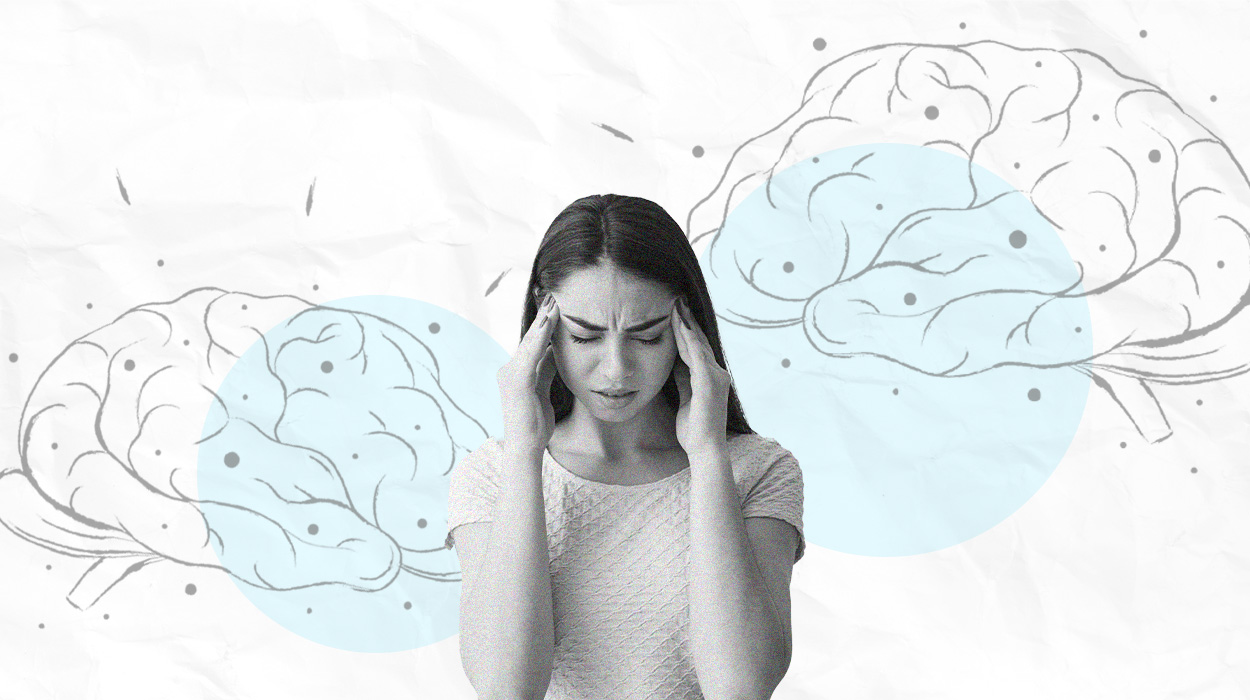 Expert's opinion
Expert's opinion
Expert's opinion
The article is a subjective view on this topic written by writers specializing in medical writing.
It may reflect on a personal journey surrounding struggles with an illness or medical condition, involve product comparisons, diet considerations, or other health-related opinions.
Although the view is entirely that of the writer, it is based on academic experiences and scientific research they have conducted; it is fact-checked by a team of degreed medical experts, and validated by sources attached to the article.
The numbers in parenthesis (1,2,3) will take you to clickable links to related scientific papers.
Nervous System Diseases: Symptoms, Causes & Treatment In 2024

Every action you take, from planning your next vacation to tensing the muscles needed to like a post on social media, depends on your nervous system. Even what your body does automatically, like regulating your blood pressure, falls under the nervous system’s control. This sophisticated system regulates every system in the body, constantly monitoring the outside world and what’s happening inside our bodies and making adjustments to keep us alive.
When the nervous system isn’t working properly, the effects are widespread. As the second leading cause of death,[1] diseases of the nervous system are associated with substantial mortality and disability. In 2016, these diseases were the underlying cause of death for more than 9 million people.[2] As medical technology enables longer lives and population growth, the rates of neurological disorders like strokes, migraines, and Alzheimer’s disease are increasing.
Key Takeaways
- Nervous system diseases are brain, spinal cord, and nerve disorders.
- Receptor cells located in sensory organs like the eyes, ears, nose, mouth, and skin collect environmental information.
- The list identifies common symptoms of a weak nervous system.
- Common nervous systems include vascular disorders, neurodegenerative diseases, demyelinating disorders, migraines, headache disorders, seizure disorders, genetic disorders, and others.
- A multidisciplinary treatment approach is often best and may involve the medical healthcare providers
What Are Nervous System Diseases?
Nervous system diseases are brain, spinal cord, and nerve disorders. The most common nervous system diseases include strokes, migraines, and Alzheimer’s disease, but there are many others, including neurodegenerative disorders like Parkinson’s disease and demyelinating disorders like multiple sclerosis.
Common symptoms of nervous system diseases include memory loss, cognitive impairment, chronic pain, muscle weakness, tremors, and seizures. A broad range of treatment options is available for managing these conditions.
What Is The Nervous System?
The nervous system comprises the brain, spinal cord, and nerves. The central nervous system contains the brain and spinal cord, while the peripheral nervous system contains the nerves connecting the brain and spinal cord to all other body parts. These two major nervous system divisions enable communication between the brain and sensory receptors throughout the body.
Receptor cells located in sensory organs like the eyes, ears, nose, mouth, and skin collect environmental information. Receptors located inside muscle cells, joints, and internal organs monitor the body’s internal conditions. Nerves connect the brain and spinal cord to the rest of the body. Information travels along nerves to the brain, and nerves carry the brain’s instructions to the muscles and organs.
The peripheral nervous system contains two major divisions. The somatic nervous system guides all voluntary movement, while the autonomic nervous system is responsible for involuntary bodily processes, like heart rate and digestion. The autonomic nervous system contains the sympathetic and parasympathetic nervous systems.
Symptoms Of Nervous System Disorders

The symptoms of nervous system diseases and disorders vary depending on the specific condition involved. Still, the following list identifies common symptoms of a weak nervous system:
- Persistent or sudden headache.
- Chronic pain.
- Numbness or tingling.
- Muscle weakness.
- Loss of sight or double vision.
- Impaired memory or cognition.
- Loss of coordination.
- Muscle rigidity.
- Tremors or seizures.
- Slurred speech.
- Back pain radiates to other parts of the body.
What Are The Common Nervous System Diseases?

Diseases that affect the nervous system cause high rates of disability and global burden. A study of 195 countries revealed that stroke, migraines, and Alzheimer’s disease were among the most common neurological disorders.[2] More than 6 million people die each year from stroke,[3] while 55 million[4] suffer from dementia. Alzheimer’s disease is the most common cause of dementia, contributing to 60-70% of diagnoses.[3] About 10% of people worldwide suffer from migraine headaches.[2]
Grouping diseases based on underlying causes is a useful framework for organizing the list of diseases affecting the nervous system:
- Vascular disorders.
- Neurodegenerative diseases.
- Demyelinating disorders.
- Migraines and headache disorders.
- Seizure disorders.
- Genetic disorders.
No nervous system disease list is exhaustive; ongoing identification of rare nervous system diseases precludes the formation of such a list.
Vascular Disorders
Vascular disorders involve blood vessels supplying blood to the brain. Strokes occur when blockages in these arteries disrupt blood flow to portions of the brain, leaving them starved for oxygen. An aneurysm is a rupture in an artery within the brain. Aneurysms often result from the rupture of arteriovenous malformations or tangled webs of blood vessels in the brain. They can cause subarachnoid hemorrhage or bleeding into the space between the brain and the skull.
A transient ischemic attack refers to a brief disruption in blood flow within the brain that may cause stroke-like symptoms but resolves within 24 hours. A transient ischemic attack is an important warning sign; without treatment, 7.5% to 17.4% of people who experience a TIA will have a stroke within three months.
Chronic stress or diabetes can lead to sympathetic nervous system disorders and increase the risk of stroke and dementia[6]. Sympathetic nervous system symptoms include elevated heart rate and high blood pressure.
Neurodegenerative Diseases
Alzheimer’s disease is the most common cause of cognitive impairment and dementia.[7] Alzheimer’s disease can only be definitively diagnosed after death when an autopsy reveals the plaques and tangled proteins responsible for the widespread degeneration. Diagnosis is based on the memory impairments, cognitive decline, and behavioral symptoms that characterize the disease.
Parkinson’s disease affects more than 6 million people worldwide. The cause of Parkinson’s disease is often unknown. Still, environmental factors like exposure to pesticides, herbicides, and heavy metals can increase the risk of developing this disorder which causes the death of neurons that produce dopamine.[8]
Dopamine is a neurotransmitter involved in the control of movement, cognitive functioning, and emotions. The symptoms of Parkinson’s disease reflect dopamine depletion and include muscle rigidity, slowness of movement, tremors, fatigue, cognitive impairment, and psychological symptoms.
Amyotrophic lateral sclerosis[9] involves a loss of motor nerve cells in the brain and spinal cord, which leads to muscle weakness and wasting. Ultimately, damage to the respiratory muscles leads to death within two to five years. About 50% of people with ALS experience behavioral changes, cognitive impairments, and language difficulties, in addition to the loss of motor function.
Demyelinating Disorders
Demyelinating disorders like multiple sclerosis occur when chronic inflammation causes the immune system to attack myelin sheaths, causing demyelination of neurons.[10] Myelin sheaths are protective coverings that help nerve cells efficiently transmit signals.
Demyelination disrupts neuronal communication, leading to a range of symptoms, including fatigue, difficulty walking, numbness, tingling, stiffness, muscle spasms, and vision changes.
Migraines, Headache Disorders, And Seizure Disorders
Migraines are characterized by disruptions in sensory processing[11] that cause nervous system issues, including fatigue, severe headache pain, light and noise sensitivity, nausea and vomiting, dizziness and vertigo, and diarrhea. The World Health Organization identifies migraines as the most disabling condition[12] for people under age 50. Tension-type headaches, cluster headaches, and other headache disorders can also reduce the quality of life.[13]
Seizures result from excessive or abnormal electrical activity in the brain. Epilepsy, or recurrent seizures, affects 65 million people, making it the world’s most common chronic neurological disorder.
Genetic Disorders
Huntington’s disease is a devastating genetic disorder[14] characterized by movement disruptions, cognitive impairments, and severe behavioral symptoms. People with Huntington’s disease typically begin experiencing symptoms in their forties or fifties, and this disease is fatal within 15 to 20 years.
Charcot-Marie-Tooth disease is one of the most common genetic neurological conditions,[15] affecting 1 in 2,500 people. The symptoms emerge in childhood and include progressive muscle weakness and atrophy in the feet and legs.
Tay-Sachs disease is caused by mutations in the HEXA gene,[16] leading to muscle weakness, impaired coordination, speech problems, and psychological disorders. Tay-Sachs occurs in 1 in 100,000 live births.
Other Causes Of Nervous System Disorders
Infections from bacteria (i.e., meningitis, syphilis, Lyme disease, etc.), viruses (i.e., rabies, West Nile, HIV, COVID-19, etc.), fungus, and parasites can also affect the nervous system. Traumatic brain and spinal cord injuries can limit physical abilities and lead to nervous system conditions. Cancer that causes brain or spinal cord tumors can also result in neurological symptoms.
Nervous System Diseases Treatments And Prevention
A wide range of options is available for treating nervous system disorders. A multidisciplinary treatment approach is often best and may involve the following medical healthcare providers:
- Neurologists treat acute strokes and are highly trained in diagnosing central nervous system diseases. They also manage nervous system disorders using medications.
- Neurosurgeons remove tumors, treat vascular disorders, and implant neurostimulation devices.
- Psychiatrists help treat nervous system disorders by prescribing medications to manage behavioral symptoms associated with nervous system disorders.
- Psychologists and neuropsychologists are highly trained in diagnosing nervous system conditions and providing therapy to treat behavioral symptoms.
- Physical therapists help patients preserve physical abilities, minimize body muscle wasting, and achieve relief for painful or stiff muscles.
- Occupational therapists can treat swallowing problems and problems of daily living caused by painful or stiff muscles and other neurological symptoms.
Medical Treatment Of Neurological Disorders
Medications are useful for treating many nervous system diseases and disorders. Cholinesterase inhibitors and the N-methyl-D-aspartate or NMDA agonist memantine have been shown to reduce cognitive decline,[7] slow disease progression, and delay nursing home care for patients with Alzheimer’s disease.
Medications that increase dopamine,[8] like Levodopa, dopamine agonists, and monoamine oxidase-b inhibitors, are used to treat Parkinson’s disease. Monoclonal antibodies and immunomodulators like Interferon can help reduce inflammation[17] associated with multiple sclerosis. Additionally, for about 70% of people with epilepsy, anti-epileptic medications enable freedom from seizures.
Neurosurgery is necessary for some neurological disorders, including some types of aneurysms or arteriovenous malformations and treatment-resistant epilepsy. Surgical implantation of devices that stimulate the vagus and trigeminal nerves can be helpful for some seizure disorders and other conditions.
Emerging Treatments
While medications and therapy can help alleviate many symptoms, people often experience residual symptoms, including peripheral neuropathy and memory, focus, and learning problems. Brain supplements can help improve memory, focus, and productivity and enhance overall brain function. Supplements promoting nerve health can provide relief from nerve pain and peripheral neuropathy. Lifestyle factors like regular exercise, quitting smoking, and a healthy diet can reduce the risk of these disorders.
Recent research has shown that alterations in the endocannabinoid system are found in common nervous system disease. Clinical trials have revealed the benefits of cannabidiol for people with Parkinson’s disease, multiple sclerosis, and seizures. Additionally, there is hope that advances in gene therapy and stem cell technology can be applied to neurological conditions.
When To See A Doctor?
If you experience any symptoms associated with nervous system disorders, you should see a healthcare provider with experience diagnosing nervous system conditions. There are many treatment options to manage these disorders.
If you experience any of the following symptoms, seek medical attention immediately:
- Severe headache with neck stiffness and fever.
- Sudden and severe headache.
- Sudden vision problems.
- Weakness or numbness, especially if only one side of the body is affected.
- Seizure.
- Head injury.
The Bottom Line
The nervous system is a complex, sophisticated network that connects your brain, spinal cord, and nerves. Disorders of the nervous system impact nearly all aspects of life and cause tremendous disability. Still, many treatment options are available for treating these disorders and managing the associated symptoms.
+ 17 sources
Health Canal avoids using tertiary references. We have strict sourcing guidelines and rely on peer-reviewed studies, academic researches from medical associations and institutions. To ensure the accuracy of articles in Health Canal, you can read more about the editorial process here
- Feigin, V.L., Vos, T., Nichols, E., Owolabi, M.O., Carroll, W.M., Dichgans, M., Deuschl, G., Parmar, P., Brainin, M. and Murray, C. (2020). The global burden of neurological disorders: translating evidence into policy. The Lancet Neurology, [online] 19(3), pp.255–265. doi:https://doi.org/10.1016/s1474-4422(19)30411-9.
- Feigin, V.L., Nichols, E., Alam, T., Bannick, M.S., Beghi, E., Blake, N., Culpepper, W.J., Dorsey, E.R., Elbaz, A., Ellenbogen, R.G., Fisher, J.L., Fitzmaurice, C., Giussani, G., Glennie, L., James, S.L., Johnson, C.O., Kassebaum, N.J., Logroscino, G., Marin, B. and Mountjoy-Venning, W.C. (2019). Global, regional, and national burden of neurological disorders, 1990–2016: a systematic analysis for the Global Burden of Disease Study 2016. The Lancet Neurology, [online] 18(5), pp.459–480. doi:https://doi.org/10.1016/s1474-4422(18)30499-x.
- Who.int. (2023). item. [online] Available at: https://www.who.int/news-room/questions-and-answers/item/mental-health-neurological-disorders.
- World (2023). Dementia. [online] Who.int. Available at: https://www.who.int/news-room/fact-sheets/detail/dementia.
- Mendelson, S.J. and Prabhakaran, S. (2021). Diagnosis and Management of Transient Ischemic Attack and Acute Ischemic Stroke. JAMA, 325(11), p.1088. doi:https://doi.org/10.1001/jama.2020.26867.
- Fuchs, F.D. and Whelton, P.K. (2020). High Blood Pressure and Cardiovascular Disease. Hypertension, [online] 75(2), pp.285–292. doi:https://doi.org/10.1161/hypertensionaha.119.14240.
- Atri, A. (2019). Current and Future Treatments in Alzheimer’s Disease. Seminars in Neurology, [online] 39(02), pp.227–240. doi:https://doi.org/10.1055/s-0039-1678581.
- Armstrong, M.J. and Okun, M.S. (2020). Diagnosis and Treatment of Parkinson Disease. JAMA, [online] 323(6), p.548. doi:https://doi.org/10.1001/jama.2019.22360.
- Masrori, P. and Van Damme, P. (2020). Amyotrophic lateral sclerosis: a clinical review. European Journal of Neurology, [online] 27(10), pp.1918–1929. doi:https://doi.org/10.1111/ene.14393.
- Höftberger, Romana, and Hans Lassmann. “Inflammatory Demyelinating Diseases of the Central Nervous System.” Handbook of Clinical Neurology, vol. 145, 2018, pp. 263–283, https://doi.org/10.1016/b978-0-12-802395-2.00019-5.
- Lambru, Giorgio, et al. “Emerging Drugs for Migraine Treatment: An Update.” Expert Opinion on Emerging Drugs, www.researchgate.net/profile/Anna-Andreou-2/publication/329254683_Emerging_drugs_for_migraine_treatment_an_update/links/5c18ead14585157ac1cb2f0d/Emerging-drugs-for-migraine-treatment-an-update.pdf.
- Steiner, T.J., Stovner, L.J., Vos, T., Jensen, R. and Katsarava, Z. (2018). Migraine is first cause of disability in under 50s: will health politicians now take notice? The Journal of Headache and Pain, [online] 19(1). doi:https://doi.org/10.1186/s10194-018-0846-2.
- Abu Bakar, N., Tanprawate, S., Lambru, G., Torkamani, M., Jahanshahi, M. and Matharu, M. (2015). Quality of life in primary headache disorders: A review. Cephalalgia, 36(1), pp.67–91. doi:https://doi.org/10.1177/0333102415580099.
- Dialogues in Clinical Neuroscience. (2022). Neuropsychiatry of Huntington’s disease. [online] Available at: https://www.tandfonline.com/doi/full/10.31887/DCNS.2007.9.2/arosenblatt.
- Barreto, L.C.L.S., Oliveira, F.S., Nunes, P.S., de França Costa, I.M.P., Garcez, C.A., Goes, G.M., Neves, E.L.A., de Souza Siqueira Quintans, J. and de Souza Araújo, A.A. (2016). Epidemiologic Study of Charcot-Marie-Tooth Disease: A Systematic Review. Neuroepidemiology, [online] 46(3), pp.157–165. doi:https://doi.org/10.1159/000443706.
- Solovyeva, V.V., Shaimardanova, A.A., Chulpanova, D.S., Kitaeva, K.V., Chakrabarti, L. and Rizvanov, A.A. (2018). New Approaches to Tay-Sachs Disease Therapy. Frontiers in Physiology, [online] 9. doi:https://doi.org/10.3389/fphys.2018.01663.
- Hauser, S.L. and Cree, B.A.C. (2020). Treatment of Multiple Sclerosis: A Review. The American Journal of Medicine, [online] 133(12), pp.1380-1390.e2. doi:https://doi.org/10.1016/j.amjmed.2020.05.049.



